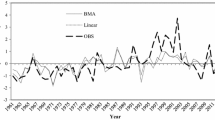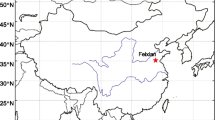Abstract
This article aims at proposing an improved statistical model for statistical downscaling of monthly precipitation using multiple linear regression (MLR). The proposed model, namely Monthly Statistical DownScaling Model (MSDSM), has been developed based on the general structure of Statistical DownScaling Model (SDSM). In order to improve the performance of the model, some statistical modifications have been incorporated including bias correction using variance correction factor (VCF) to improve the computed variance pattern. We illustrate the effectiveness of the proposed model through its application to 288 rain gauge stations scattered in different climatic zones of Iran. Comparison between the results of SDSM and the proposed MSDSM has indicated superiority of the proposed model in reproducing long-term mean and variance of monthly precipitation. We found that the weakness of MLR method in estimating variance has been considerably improved by applying VCF. We showed that the proposed model provides a promising alternative for statistical downscaling of precipitation at monthly time scale. An investigation of the effects of climate change in different climatic zones of Iran by the use of Representative Concentration Pathways (RCPs) has shown that the most significant change is an increase in precipitation in fall and that the largest share of this increase belongs to arid climate.








Similar content being viewed by others
References
Anandhi A, Srinivas V, Nanjundiah RS, Nagesh Kumar D (2008) Downscaling precipitation to river basin in India for IPCC SRES scenarios using support vector machine. Int J Climatol 28:401–420
Arora V, Boer G (2010) Uncertainties in the 20th century carbon budget associated with land use change. Glob Change Biol 16:3327–3348
Arora V, Boer G (2014) Terrestrial ecosystems response to future changes in climate and atmospheric CO2 concentration. Biogeosciences 11:4157
Barnett V, Lewis T (1974) Outliers in statistical data. Wiley, Hoboken
Battiti R (1994) Using mutual information for selecting features in supervised neural net learning. IEEE Trans Neural Networks 5:537–550
Bowden GJ, Dandy GC, Maier HR (2005a) Input determination for neural network models in water resources applications. Part 1—background and methodology. J Hydrol 301:75–92
Bowden GJ, Maier HR, Dandy GC (2005b) Input determination for neural network models in water resources applications. Part 2. Case study: forecasting salinity in a river. J Hydrol 301:93–107
Dibike YB, Coulibaly P (2005) Hydrologic impact of climate change in the Saguenay watershed: comparison of downscaling methods and hydrologic models. J Hydrol 307:145–163
Dixon W (1953) Processing data for outliers. Biometrics 9:74–89
Fistikoglu O, Okkan U (2010) Statistical downscaling of monthly precipitation using NCEP/NCAR reanalysis data for Tahtali River basin in Turkey. J Hydrol Eng 16:157–164
Fowler H, Blenkinsop S, Tebaldi C (2007) Linking climate change modelling to impacts studies: recent advances in downscaling techniques for hydrological modelling. Int J Climatol 27:1547–1578
Fu Q, Lin L, Huang J, Feng S, Gettelman A (2016) Changes in terrestrial aridity for the period 850–2080 from the community earth system model. J Geophys Res Atmos 121:2857–2873
Füssel H-M, Toth FL, van Minnen JG, Kaspar F (2003) Climate impact response functions as impact tools in the tolerable windows approach. Clim Change 56:91–117
Goly A, Teegavarapu RSV, Mondal A (2014) Development and evaluation of statistical downscaling models for monthly precipitation. Earth Interact 18:1–28
Goyal MK, Ojha C, Burn DH (2011) Nonparametric statistical downscaling of temperature, precipitation, and evaporation in a semiarid region in India. J Hydrol Eng 17:615–627
Guyon I, Elisseeff A (2003) An introduction to variable and feature selection. J Mach Learn Res 3:1157–1182
Hashmi MZ, Shamseldin AY, Melville BW (2011) Comparison of SDSM and LARS-WG for simulation and downscaling of extreme precipitation events in a watershed. Stoch Env Res Risk Assess 25:475–484
Hashmi MZ, Shamseldin AY, Melville BW (2013) Statistically downscaled probabilistic multi-model ensemble projections of precipitation change in a watershed. Hydrol Process 27:1021–1032
Hellstrom C, Chen D, Achberger C, Raisanen J (2001) Comparison of climate change scenarios for Sweden based on statistical and dynamical downscaling of monthly precipitation. Clim Res 19:45–55
Hessami M, Gachon P, Ouarda TB, St-Hilaire A (2008) Automated regression-based statistical downscaling tool. Environ Model Softw 23:813–834
Huth R, Kyselý J (2000) Constructing site-specific climate change scenarios on a monthly scale using statistical downscaling. Theoret Appl Climatol 66:13–27
Jeong D, St-Hilaire A, Ouarda T, Gachon P (2012) Comparison of transfer functions in statistical downscaling models for daily temperature and precipitation over Canada. Stoch Env Res Risk Assess 26:633–653
Kalnay E, Kanamitsu M, Kistler R, Collins W, Deaven D, Gandin L, Iredell M, Saha S, White G, Woollen J (1996) The NCEP/NCAR 40-year reanalysis project. Bull Am Meteor Soc 77:437–471
Karandish F, Mousavi SS, Tabari H (2016) Climate change impact on precipitation and cardinal temperatures in different climatic zones in Iran: analyzing the probable effects on cereal water-use efficiency. Stoch Environ Res Risk Assess. doi:10.1007/s00477-016-1355-y
Khalili K, Tahoudi MN, Mirabbasi R, Ahmadi F (2016) Investigation of spatial and temporal variability of precipitation in Iran over the last half century. Stoch Env Res Risk Assess 30:1205–1221
Kohavi R (1995) A study of cross-validation and bootstrap for accuracy estimation and model selection. IJCAI 14:1137–1145
Liu H, Yu L (2005) Toward integrating feature selection algorithms for classification and clustering. IEEE Trans Knowl Data Eng 17:491–502
Liu H, Sun J, Liu L, Zhang H (2009) Feature selection with dynamic mutual information. Pattern Recogn 42:1330–1339
Maurer EP, Hidalgo HG (2008) Utility of daily vs. monthly large-scale climate data: an intercomparison of two statistical downscaling methods. Hydrol Earth Syst Sci 12:551–563
May RJ, Dandy GC, Maier HR, Nixon JB (2008a) Application of partial mutual information variable selection to ANN forecasting of water quality in water distribution systems. Environ Model Softw 23:1289–1299
May RJ, Maier HR, Dandy GC, Fernando TG (2008b) Non-linear variable selection for artificial neural networks using partial mutual information. Environ Model Softw 23:1312–1326
Najafi M, Moradkhani H, Wherry S (2011) Statistical downscaling of precipitation using machine learning with optimal predictor selection. J Hydrol Eng 16:650–664
Nasseri M, Tavakol-Davani H, Zahraie B (2013) Performance assessment of different data mining methods in statistical downscaling of daily precipitation. J Hydrol 492:1–14
Ojha C, Goyal MK, Adeloye A (2010) Downscaling of precipitation for lake catchment in arid region in India using linear multiple regression and neural networks. Open Hydrol J 4:122–136
Olsson J, Uvo C, Jinno K, Kawamura A, Nishiyama K, Koreeda N, Nakashima T, Morita O (2004) Neural networks for rainfall forecasting by atmospheric downscaling. J Hydrol Eng 9:1–12
Prudhomme C, Reynard N, Crooks S (2002) Downscaling of global climate models for flood frequency analysis: where are we now? Hydrol Process 16:1137–1150
Raje D, Mujumdar P (2011) A comparison of three methods for downscaling daily precipitation in the Punjab region. Hydrol Process 25:3575–3589
Refaeilzadeh P, Tang L, Liu H (2009) Cross-validation. In: Liu L, Özsu MT (eds) Encyclopedia of database systems. Springer, New York
Sachindra D, Huang F, Barton A, Perera B (2014a) Statistical downscaling of general circulation model outputs to precipitation—part 1: calibration and validation. Int J Climatol 34:3264–3281
Sachindra D, Huang F, Barton A, Perera B (2014b) Statistical downscaling of general circulation model outputs to precipitation—part 2: bias-correction and future projections. Int J Climatol 34:3282–3303
Semenov MA, Brooks RJ, Barrow EM, Richardson CW (1998) Comparison of the WGEN and LARS-WG stochastic weather generators for diverse climates. Climate Res 10:95–107
Tan P-N, Steinbach M, Kumar V (2006) Classification: basic concepts, decision trees, and model evaluation. Introduction to data mining, vol 1, pp 145–205
Tavakol-Davani H, Nasseri M, Zahraie B (2013) Improved statistical downscaling of daily precipitation using SDSM platform and data-mining methods. Int J Climatol 33:2561–2578
Taylor KE, Stouffer RJ, Meehl GA (2012) An overview of CMIP5 and the experiment design. Bull Am Meteor Soc 93:485–498
Tripathi S, Srinivas V, Nanjundiah RS (2006) Downscaling of precipitation for climate change scenarios: a support vector machine approach. J Hydrol 330:621–640
Wilby RL, Hay LE, Leavesley GH (1999) A comparison of downscaled and raw GCM output: implications for climate change scenarios in the San Juan River basin, Colorado. J Hydrol 225:67–91
Wilby RL, Dawson CW, Barrow EM (2002) SDSM—a decision support tool for the assessment of regional climate change impacts. Environ Model Softw 17:145–157
Wilby R, Charles S, Zorita E, Timbal B, Whetton P, Mearns L (2004) Guidelines for use of climate scenarios developed from statistical downscaling methods. Supporting material of the Intergovernmental Panel on Climate Change, available from the DDC of IPCC TGCIA, 27
Willems P, Vrac M (2011) Statistical precipitation downscaling for small-scale hydrological impact investigations of climate change. J Hydrol 402:193–205
Willems P, Arnbjerg-Nielsen K, Olsson J, Nguyen VTV (2012) Climate change impact assessment on urban rainfall extremes and urban drainage: methods and shortcomings. Atmos Res 103:106–118
Wood AW, Leung LR, Sridhar V, Lettenmaier D (2004) Hydrologic implications of dynamical and statistical approaches to downscaling climate model outputs. Clim Change 62:189–216
Acknowledgements
This study has been carried out in the Water Institute of the University of Tehran. Authors appreciate supports of the institute for this research. Also, the authors acknowledge and appreciate the constructive comments of the anonymous reviewers.
Author information
Authors and Affiliations
Corresponding author
Additional information
Editorial responsibility: M. Abbaspour.
Rights and permissions
About this article
Cite this article
Pahlavan, H.A., Zahraie, B., Nasseri, M. et al. Improvement of multiple linear regression method for statistical downscaling of monthly precipitation. Int. J. Environ. Sci. Technol. 15, 1897–1912 (2018). https://doi.org/10.1007/s13762-017-1511-z
Received:
Revised:
Accepted:
Published:
Issue Date:
DOI: https://doi.org/10.1007/s13762-017-1511-z




